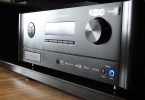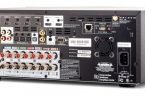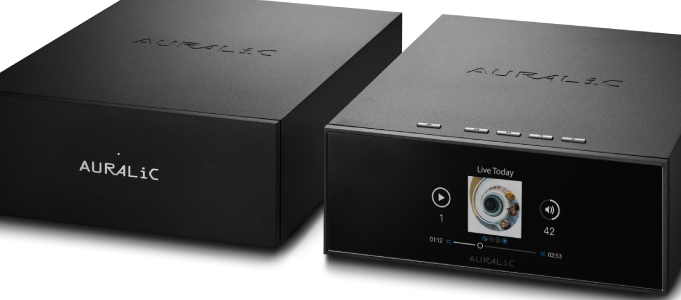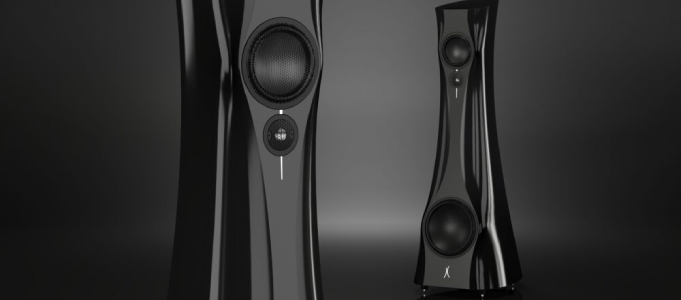Anthem MRX-720 7.2 Channel ARC Genesis AV Receiver Review

We reviewed the Anthem MRX-1120 two years ago, and while the AV Receiver range has not changed since, a series of free firmware upgrades have been released. So we jumped at the chance to review the smaller MRX-720 featuring ARC Genesis Room Correction.
Anthem
MRX-720
7.2 Channel AV Receiver with ARC Genesis
$3,899 RRP

One of the things I love about being an AV enthusiast and being a reviewer is the surprises. Sure, every AV receiver has its own unique feature set and sonic signature, but after a while, you learn what to expect at a given price-point.
That's until something comes along that upsets the status quo, which as it turns out, is what happened when I received Anthem's MRX-720 featuring ARC Genesis room-correction, for review.
When I reviewed Anthem's MRX-1120 a little over two years ago, it deservedly received a glowing review. Anthem is a brand that favours longer product life-cycles, and Anthem's AVR lineup is still the same as it was back then. But to say nothing's changed couldn't be further from the truth.
In addition to rolling out several major firmware updates, Anthem has rebuilt their ARC (Anthem Room Correction) software from the ground-up. And in a refreshing change, they've made it available to both new and existing owners free of charge. So, given the opportunity to review Anthem's $3,899 MRX-720 and new ARC Genesis software, I jumped at the chance.
The previous version of ARC which was heavily influenced by a three-year study undertaken by Canada's National Research Council, entitled The Athena Project, was widely regarded as one of the best room correction systems available. With the help of Athena's Projector Leader, Dr Peter Schuck, Anthem has expanded upon that research with the release of ARC Genesis, which they claim can “transform the sound in any space.”

As for the seven-channel MRX-720, it shares a lot in common with the $5,599 eleven channel MRX-1120 previously reviewed. Notably, it delivers 140 watts (continuous, two channels into 8 ohms) for its main channels, and 60 watts (continuous, two channels into 8 ohms) for its remaining two channels. However, the MRX-720 does forgo a toroidal transformer in favour of an EI transformer for its main five channels, but just like the MRX-1120, it uses Class D-amplification for its remaining channels.
The MRX-720 will support either a 7.2 or 5.2.2 speaker configurations via its seven internal amplifiers. For larger systems, the MRX-720 will happily expand up to 11.2 channels with external amplification via its 11.2 channel pre-outs.
The MRX-720 will also decode any of the Dolby and DTS codecs, including Dolby Atmos and DTS:X. While both Auro and IMAX Enhanced are both missing from the list of Anthem's supported codecs, titles in either format are scarce.
For streaming, the MRX-720 uses DTS Play-Fi, which in addition to making it Alexa compatible, enables it to stream Tidal, Pandora, Napster, Spotify, SiriusXM, iHeartRADIO, DEEZER, Internet Radio, kkbox, Juke!, Amazon Music, BBC, ESPN and NPR.
Of course, should you have a library of digital titles, DTS Play-Fi will allow you to playback FLAC, WAV, ALAC, MP3 and AAC supporting high resolution files up to 24/96.
Just like every other audio company, Anthem has also dipped its toes into the wireless/Bluetooth speaker waters1 via parent company Paradigm. The MRX-720 is compatible with Paradigm's PW-600 and PW-800 wireless speakers.

what's in the box?
While indeed not small in terms of size or weight (439x 165x 375mm and 14kg), the MRX-720 is far from the behemoth you would expect from an AVR claiming “separates like performance”.
Nonetheless, temporarily replacing my Denon AVC- X8500H, the MRX-720 looked every part a high-end piece of AV equipment; its black aluminium faceplate, coupled with curved edges, narrow LED display and solitary 'dial' giving it a sleek, minimalistic appearance that is decidedly Anthem.
You're not going to find much in the way of legacy video connections, the rear panel offering seven HDMI 2.0 inputs, two HDMI outputs with ARC (audio return channel) on HDMI 1 and MHL on HDMI 7.
The MRX-720 offers five analogue audio inputs, three optical inputs, one optical output, two coaxial inputs, zone 2 audio inputs, line-level inputs, RS-232 input, IR input, 12-volt trigger, FM antenna, wireless antenna connections, LAN connection and a USB jack, which is reserved for service.
Rounding out the MRX-720's connections are pre-outs for up to 11.2 channels of external amplification and two parallel subwoofer outputs.
The speaker binding posts are of high quality and laid out in a top to bottom configuration (red above black).
Its undeniable Anthem takes setup seriously, the box including an aluminium mic stand to accompany the high-quality microphone. The box also included a USB cable which is used to connect the microphone to a laptop, an ethernet cable and of course a remote control.
The remote is also attractive, complementing the MRX-720's high-end appearance. It sits nicely in hand with all needed controls in easy reach. While the buttons are well laid out, they are on the smaller side, and automatic backlighting would have been preferable over the dedicated back-lighting button.

setup
With the advent of HDMI, connection to modern AV Receivers is relatively straight forward in all but the most complicated of systems. While there was sufficient space around the speaker binding posts, laying the binding posts next to one another rather than on top of one another would make speaker connection both more accessible and safer. However, there's a strong chance you're only going to need to do this once.
The absence of independent subwoofer outputs, particularly given the MRX-720's $3,899 asking price was surprising. Understandably, there's a need to sum the output from both subs for playback and room-correction, however, not being able to specify neither distances or levels makes subwoofer setup more difficult, particularly for those who with limited subwoofer placement options.
Regardless of where your subs are located in your room, it's essential to level match the subs before calibration.

arc genesis
 Arc Genesis comes in several OS flavours, including Window and Mac, with support for apple and android coming. While I like the convenience of an app, a laptop provides both a larger display area and the ease of navigation with a mouse.
Arc Genesis comes in several OS flavours, including Window and Mac, with support for apple and android coming. While I like the convenience of an app, a laptop provides both a larger display area and the ease of navigation with a mouse.
After downloading ARC Genesis from the Anthem website, you need to a calibration file for the factory-calibrated microphone. While this may sound complicated, it's merely a matter of inputting your microphone's serial number and downloading the microphone specific file.
Upon opening Genesis for the first time, you're given the option to use the software in either Auto or Professional mode. If you're not prepared to dive into the rabbit hole, I'd strongly suggest you use Auto mode.
From the home screen, you also have the option of Launching' Quick Measure'. This tool was invaluable, not only allowing me to level match my subs but also experiment with placement and watch the effect in real-time.
There are also four-speaker profiles onboard the MRX-720 where calibrations and speaker layouts can be stored. Fancy having a separate calibration/profile for two-channel listening? Here, you're given the option to save multiple speaker profiles and calibrations when running Genesis.
Moving to the calibration itself, ARC now provides the option to measure between five to ten different positions. While there's the temptation to dive straight in, I'd strongly recommend you visit the ARC Genesis homepage and follow the instructions there for accurate microphone placement.
Depending on whether you've chosen Professional or Auto (this can be changed at any time in Preferences), you'll have the option to upload the correction values directly to the AVR or review and customise them before uploading.

If you've chosen the Profesional option, things get interesting. Where ARC previously limited correction to 5kHz, there's now the option to go up to 20kHz.
If you're given to tinkering, you can alter everything from room gain, bass response, high-frequency roll-off and tilt, which can either boost or lower high-end frequencies. Although most users are going to want to avoid adjusting these types of controls, there's enough to keep advanced users busy.
During the period of the review, I used both the Auto and Professional options. While I mostly let Genesis 'do its thing' the professional option did allow me to review what Genesis had done. With perhaps the exception of Dirac, Genesis is the only room correction solution that has accurately set my crossovers without manual intervention.
While there are a plethora of options available for advanced users, new users shouldn't be put off. Auto mode is intuitive and straightforward enough to follow, while still harnessing all the power that Genesis has to offer.

performance
Like the Blu-ray, the 4K UHD of Fury is a 'sonic tour de force', and the type that the MRX-720 revels in. I've seen this movie played on several different systems including my own and while it always sounds good, I can't ever recall it sounding this good.
Here the 720's amps showed just how capable they are, driving my speakers to the necessary sound levels to create an engaging home theatre experience and beyond. Tank shells ricocheted around the large sound-field that the MRX-720 and Genesis created, often startling and placing me slap bang in the middle of the battle, sans the blood, grime and mud.
The benefits of using ARC Genesis were readily apparent not only in the way it created a seamless soundscape, but in the bass delivery. Simply put, I've never heard bass this good in my listening room from any other room correction software, including the previous incarnation of ARC.
Firing up John Wick (pun intended) on 4K Blu-ray, gunshots were given a tactile sense of slam and precision. I've always favoured Audyssey Bass EQ in my listening room for its ability to both time-align and balance dual subs. Genesis, however, even with the 720's parallel outputs was the superior of the two.
The best part? It was all done with Genesis' Auto calibration mode, without any manual intervention.
Playing the Dolby Atmos soundtrack on the 4K UHD version of The Greatest Showman, the MRX-720 put in a first-class performance, not quite matching my Denon AVC-X8500 in terms of finesse, or subtlety.
Moving onto the car-chase scene in Ready Player One, however, the combination of the MRX-720's powerful amps and ARC Genesis came together to set another new benchmark for performance in my listening room. The sound of debris, dinosaurs and a giant gorilla moved deftly about the listening space with a sense of precision and power that created one of my better home theatre experiences to date.

conclusion
 The Anthem MRX-720 is a both a natural sounding and powerful AVR that well and truly lives up to Anthem's claims of “separates like performance”.
The Anthem MRX-720 is a both a natural sounding and powerful AVR that well and truly lives up to Anthem's claims of “separates like performance”.
Throw ARC Genesis into the mix, and you've got an AVR that frankly has no right sounding this good for it's price-point.
It looks as though Anthem may have me eating my words regarding parallel sub outputs, at least in my listening environment. As with the MRX-1120 that we reviewed a couple of years back, the MRX-720 is big, bold and cinematic.
The Anthem MRX-720 may go on to become a new benchmark in my home theatre, and the MRX-720 has earned a StereoNET Applause Award for not only Best in Class, but also Best Value.
For more information, visit Anthem.

Tony O'Brien
As the owner of Adelaide based ‘Clarity Audio & Video Calibration’, Tony is a certified ISF Calibrator. Tony is an accomplished Audio-Visual reviewer specialising in theatre and visual products.
Posted in:Home Theatre Amplifiers AV Receivers & Processors Applause Awards 2019
Tags: anthem audio active
JOIN IN THE DISCUSSION
Want to share your opinion or get advice from other enthusiasts? Then head into the Message Forums where thousands of other enthusiasts are communicating on a daily basis.
CLICK HERE FOR FREE MEMBERSHIP
Trending
applause awards
Each time StereoNET reviews a product, it is considered for an Applause Award. Winning one marks it out as a design of great quality and distinction – a special product in its class, on the grounds of either performance, value for money, or usually both.
Applause Awards are personally issued by StereoNET’s global Editor-in-Chief, David Price – who has over three decades of experience reviewing hi-fi products at the highest level – after consulting with our senior editorial team. They are not automatically given with all reviews, nor can manufacturers purchase them.
The StereoNET editorial team includes some of the world’s most experienced and respected hi-fi journalists with a vast wealth of knowledge. Some have edited popular English language hi-fi magazines, and others have been senior contributors to famous audio journals stretching back to the late 1970s. And we also employ professional IT and home theatre specialists who work at the cutting edge of today’s technology.
We believe that no other online hi-fi and home cinema resource offers such expert knowledge, so when StereoNET gives an Applause Award, it is a trustworthy hallmark of quality. Receiving such an award is the prerequisite to becoming eligible for our annual Product of the Year awards, awarded only to the finest designs in their respective categories. Buyers of hi-fi, home cinema, and headphones can be sure that a StereoNET Applause Award winner is worthy of your most serious attention.




















